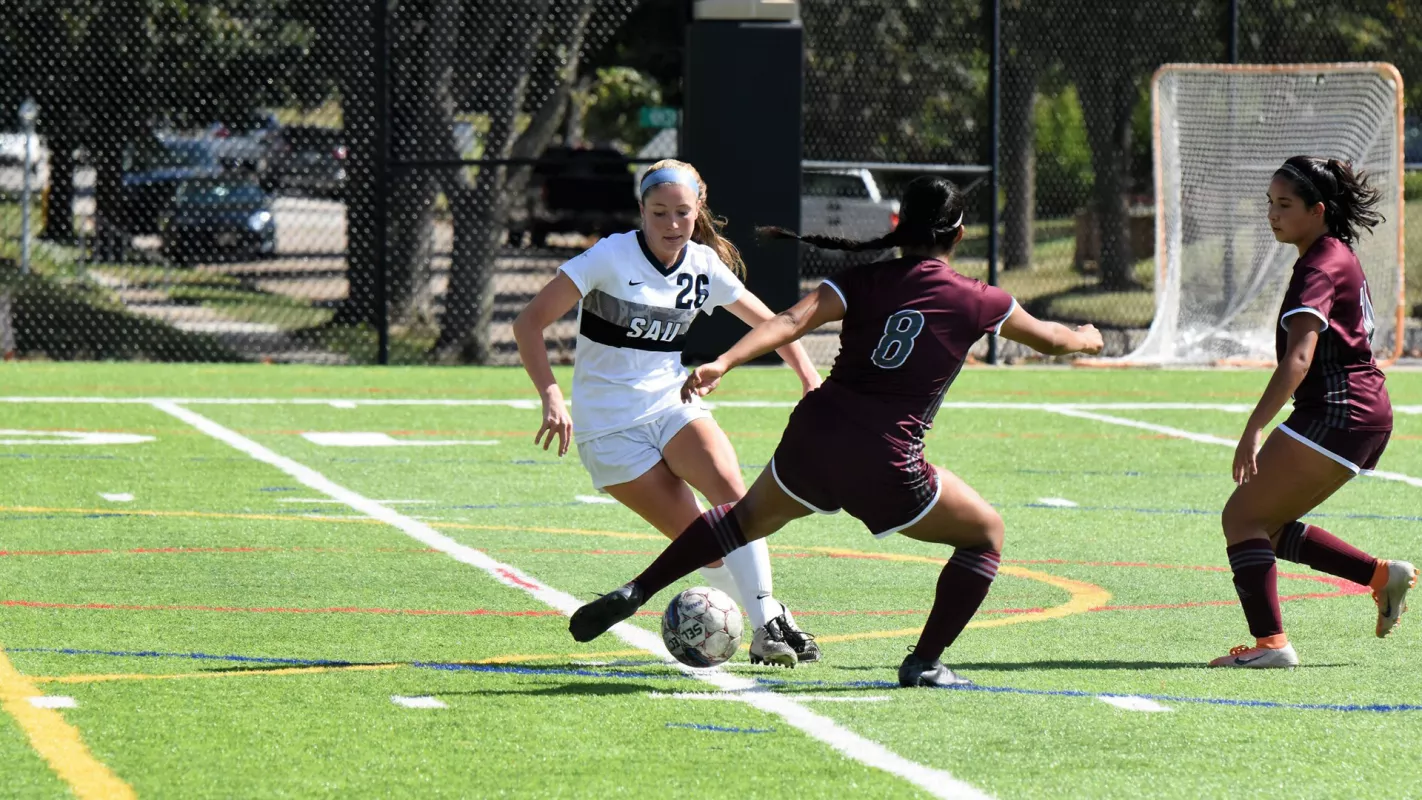Complex procedure helps young athlete with heart condition
Keeli Frerichs was a star soccer player and avid exerciser until a heart condition sidelined her. The path back to an active lifestyle brought the St. Ambrose student to UI Hospitals & Clinics, home to one of the few experts in the nation who perform a new procedure to treat the condition.
Keeli Frerichs had her sights set on her soccer team at St. Ambrose University repeating as conference champion and returning to the NAIA national tournament, until a disturbingly slow heart rate derailed her career—and threatened her life.
How fortunate for her, though, that less than an hour from her school in Davenport, Iowa, was a University of Iowa Hospitals & Clinics cardiac electrophysiologist named Paari Dominic, MBBS, MPH, one of the few doctors in the nation who specialize in a new procedure to treat the condition, known as cardio-inhibitory vasovagal syncope and symptomatic sinus bradycardia.
Dominic performed a cardioneuroablation, the first and only doctor to do so in Iowa.
Now, the 21-year-old Frerichs is living her life to the fullest.
“I went from exercising every day, playing soccer every day, to not being able to do anything,” says Frerichs, who grew up in Geneseo, Illinois, and is now a doctoral student in physical therapy at St. Ambrose. “Being able to exercise was something I had taken for granted, and it’s something I don’t take for granted now.”

A disheartening discovery
In December 2021, one month after her soccer season had ended, Frerichs visited a doctor about weight loss she had been experiencing. The sophomore was told at that appointment that her resting heart rate was lower than what is considered normal, which is between 60 to 100 beats per minute.
“I didn’t feel it,” Frerichs recalls. “I had no idea it was going on at all.”
Even after Frerichs regained lost weight, her resting heart rate remained lower than it should be. She underwent a series of tests, but none showed any clear-cut symptoms of her condition. Worse, her resting heart rate continued to decline, reaching a low of 30 beats per minute. She was experiencing headaches while lying down, and her hands would go numb when she slept.
Sixteen months after the initial diagnosis, Frerichs and her parents met with Dominic, a cardiac electrophysiologist and associate professor of internal medicine–cardiovascular medicine in the Carver College of Medicine.
It was a wise choice: Dominic has long been interested in the physiology of the heart. As a fellow at UI Hospitals & Clinics between 2007 and 2012, Dominic had worked alongside Brian Olshansky, MD, emeritus professor of internal medicine–cardiovascular medicine and a world expert in vasovagal syncope, a condition that causes the heart rate and blood pressure to drop suddenly, leading to fainting.
Since then, Dominic had continued studying heart rhythms and had been following the evolution of cardioneuroablation, a new procedure that involves burning nerve endings inside the heart to increase the resting heart rate and to prevent a sudden drop in heart rate leading to fainting. Dominic had successfully performed cardioneuroablations with Louisiana Health Sciences Center, in Shreveport, before rejoining UI Hospitals & Clinics in January 2023, making him among a select few in the nation as experts in the method.
Dominic began Frerichs’ first appointment by pulling up an app on his phone that tracked a person’s body mass index.
“I said to her, ‘Your heart rate cannot be so much lower than mine if we have the same BMI. There’s more to this than simply weight loss,’” Dominic recalls.
A good candidate for a newer procedure
Frerichs had been referred to UI Hospitals & Clinics when she and her family had decided they wanted a second opinion. One possibility at the time was to implant a pacemaker, which would restore and maintain a consistent heart rate but would mean having a piece of depreciating hardware inside the body.
“I was preparing for the appointment,” Dominic recalls, “going through her chart and reading everything about her and the work-up she had done so far, and I thought, ‘Wow, she is a candidate for a cardioneuroablation because of how young she is, the long-term risks of having a pacemaker generally in young people, and the fact she likes to exercise.’ She checked every box clinically.”
Despite thinking the procedure would be a good option, Dominic wanted Frerichs and her parents to know the benefits and potential drawbacks.
“At that time, I wasn’t really interested in them making a decision,” he says. “I wanted them to walk out of the clinic knowing what their options were and the scientific thinking behind those options.
“I get concerned when patients and their families don’t ask questions,” Dominic continues, explaining his approach to patients. “I think, ‘They’re not getting what I’m saying.’ If somebody was telling me something they need to do to my heart, I would be asking them thousands of questions. I want to make sure they’re asking questions.”
Frerichs says she and her parents walked out of their appointment with Dominic feeling assured and informed.
“The way he presented himself to us, his friendliness, it was easy to put our faith and trust in him,” Frerichs says. “We needed something to be done, and if this was our best option, we were going to try it.”
What is cardioneuroablation?
A cardioneuroablation procedure involves a series of delicate, intricate steps. The first is to locate the vagus nerve, one of two planks of the central nervous system that controls the heartbeat. The vagus nerve has ganglia, or endings, like dead-end tributaries branching from a river. Cardiac electrophysiologists seek to burn those endings, while avoiding burning the nerve itself, which regulates other important bodily functions.
To do that, doctors insert two catheters through the patient’s groin and weave them through blood vessels into the heart. One catheter detects electrical signals associated with the vagus nerve, and the other catheter emits radio frequencies from the tip to heat up and burn the ganglia cells. It’s very roughly like running wires within the walls of a house to disconnect a faulty outlet in the attic.
Dominic is the only electrophysiologist in Iowa who does cardioneuroablations and is one of a handful of doctors nationwide to successfully execute the procedure, which was first performed in the United States in 2019.
“It isn’t simple or straightforward. It is a complex procedure,” Dominic says.

Resuming regular activity
Dominic operated on Frerichs in April, a four-hour procedure and his ninth successful cardioneuroablation.
Frerichs woke up from the procedure and was informed her resting heart rate was 60 to 70 beats per minute, well within the healthy, normal range.
“That’s when I knew it had worked,” she says.
Now, after more than a year and a half of a life on pause, a life without physical activity, a life beset by a condition that withheld an answer, Frerichs describes her life as normal again.
“All the worries I had,” she says, pausing, “are gone.”
If you are concerned about an irregular heartbeat or are experiencing symptoms, you should be evaluated by a cardiologist who specializes in heart arrhythmias.